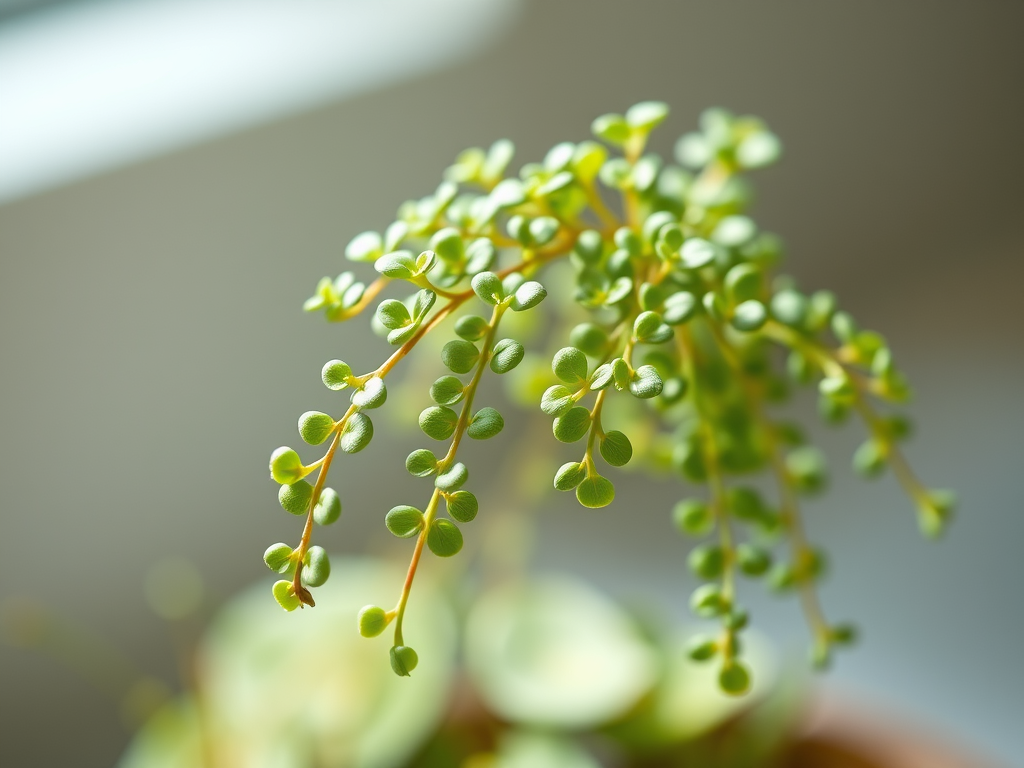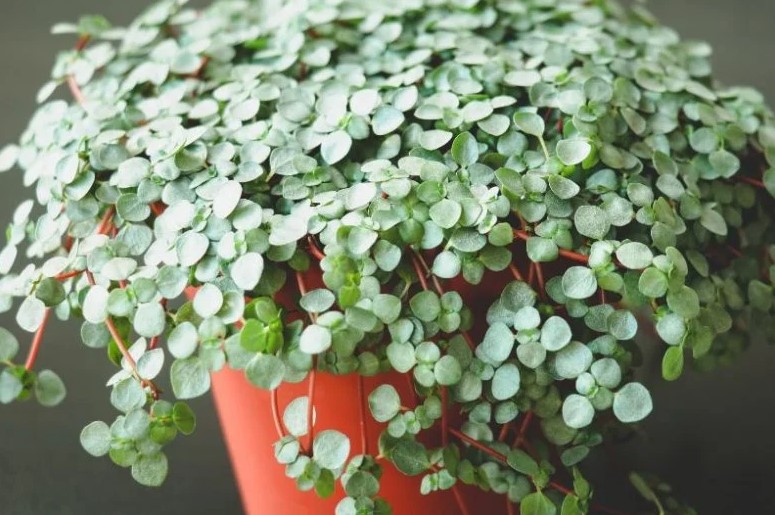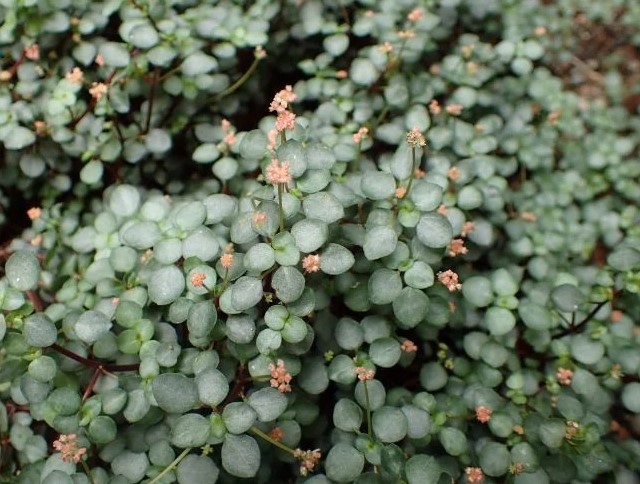Pilea Glauca Mystifall fascinates beyond a mere horticultural attraction; this exquisitely delicate species enchants one, be it an amateur or a very experienced plant fancier. Airy in his foliage, dashed with silvery shine and mystery, he speaks for one’s admiration and attention.
This enchanting plant, full of character and elegance in its own way, epitomizes the art of rearing greeneries that would not only add beauty to our surroundings but also help soothe our souls with their serene presence. Further into the exquisite Pilea Glauca Mystifall is a whole world of wonder waiting to be explored and cherished.
Overview of Pilea Glauca Mystifall
Pilea Glauca Mystifall, more familiarly known as the “Mystifall” pilea, is one of the more particular and interesting plants to have reached a wider audience of late. This exotic beauty showcases delicate silvery-blue leaves cascading down, adding an interesting touch to any interior setting. A tiny size with strikingly captivating looks, the Pilea Glauca Mystifall is sure to be in demand by any plant lover looking for something that adds a little bit of fantasy into their homes.
It loves to grow under bright but indirect light, and these qualify it as best-suited for indoor areas where sunlight is filtered in. It needs moderate water conditions, mainly soil that is moist yet well-drained. Again, proper care that ensures this plant lives an active and healthy life will include a good balance between lighting, watering, and type of soil mixture it is exposed to.
Pilea Glauca Mystifall is quite easy to propagate by means of stem cuttings, thus enabling the enthusiasts to build up their collection or simply share the pleasure of this plant with others. Generally hardy against pests and diseases, it is nonetheless recommended to check the plant from time to time for the most typical problems, such as spider mites or fungal infections.

Characteristics of Pilea Glauca Mystifall
Pilea Glauca Mystifall, commonly known as the Artillery Plant, is an extraordinary succulent that contains a lot of unique features, making the plant famous in the flora world. Here are the key characteristics of the plant:
Foliage: The Pilea Glauca Mystifall features delicate, round leaves that are a silvery-blue color, resembling miniature lily pads. The velvety texture of the leaves adds to its allure, making it a visually stunning addition to any indoor space.
Size and Growth Habit: This plant typically stays compact, reaching a height of around 6-8 inches. Its bushy growth habit allows it to fill out nicely in a container, making it an ideal choice for small spaces or as part of a plant arrangement.
Tolerance to Low Light: Pilea Glauca Mystifall is known for its adaptability to lower light conditions, making it suitable for areas in your home with less natural light. However, it thrives best in indirect sunlight, which helps maintain its vibrant foliage color.
Versatile Decorative Plant: Due to its unique appearance and easy maintenance, Pilea Glauca Mystifall is a versatile plant that can be used as a standalone centerpiece or as part of a succulent garden. Its aesthetic appeal and low-care requirements make it a favorite choice for plant styling and décor enthusiasts.
Knowing the distinctive character of Pilea Glauca Mystifall will enable plantation lovers to admire and care for this most enchanting succulent, adding beauty to their indoor greenery collection.
Pilea Glauca Mystifall Care and Maintenance
Water Pilea Glauca Mystifall when the top inch of the soil has dried from the last watering to make sure it hails the best possible care. That simply means in soils which are always a bit moist but never dry or too saturated. Avoid overwatering because it may bring root rot to this plant.
For light requirements, Pilea Glauca ‘Mystifall’ needs bright, indirect sunlight. Locate it near a window where it will get good light without having to bear the brunt of direct sun rays that may burn the tender leaves. Casual rotation of the plant will help in its growth on all sides evenly.
Soil and Fertilizing: Well-draining potting mix helps prevent waterlogged roots. Fertilize your Pilea Glauca ‘Mystifall’ lightly during the growing season for healthy growth. Take a balanced, liquid fertilizer at half of the normal strength every four to six weeks.
Follow these care and maintenance tips, and your Pilea Glauca Mystifall will be healthy and continue to show off its striking beauty. Keep in mind how much water it will take, how much light it needs, what kind of soil is best to plant it on, and what kind of fertilizer must be applied as it grows, for indeed a happy and healthy plant adds beauty to every living space.
Watering Needs
This plant will appreciate a consistent level of moisture, but not one that would make it struggle from waterlogging. Let it be so that the top inch of soil dries out between waterings to prevent root rot, and don’t let it stand in standing water, as it can result in health problems for the plant.
A well-draining potting mix will help the soil retain a good balance of moisture. Water your Pilea Glauca Mystifall once a week during the growing season when the top of the soil is starting to feel a little dry to the touch. Caution not to overwater, changing frequency according to environmental temperature and humidity changes that may occur to keep conditions optimal for growth.
During winter months when it is dormant, reduce the frequency to avoid over-saturation that may lead to root problems. Observe your plant’s reaction to watering, as wilting or yellowing of leaves can signify overwatering or under-watering. A balance has to be struck for your Pilea Glauca Mystifall to be healthy and fresh.
Light Requirements
Pilea Glauca Mystifall can thrive well under bright, indirect light. Place it near the window so it may get ample sunlight, but at the same time, the delicate leaves should not get scorched from the strong rays. If the amount of supplied light is not good enough, then it is possible to consider additional means of lighting, such as fluorescent light and grow lights for indoor plants.
Too little light causes the plant to grow a bit leggy and lack some vibrancy in the foliage. And way too little is so much better than way too much, because way too much will burn the leaves and stress the poor thing. Check on the plant for signs that it’s getting enough light where it is sitting. Rotate periodically to ensure even growth on both sides of the plant and to prevent leaning into the light source.
This will come in handy during winter or when the plant is to be set up in a low-light area. Try to keep the light balanced for a healthy Pilea Glauca Mystifall. Keep in mind that this is among the most integral parts of its care, and as such, it has a huge impact on its look and health.

Tips for Soil and Fertilizing
Pilea Glauca Mystic Fall requires proper soil mix and fertilizer application to grow well. Some of the aspects that will keep this peculiar plant healthy and looking its best include:
Soil Composition:
- Pilea Glauca Mystifall thrives in well-draining, aerated soil. A mix of peat moss, perlite, and sand provides the ideal medium for root development.
- Avoid compacted or heavy soils that can lead to waterlogging, which may cause root rot in the plant.
Fertilization:
- Use a balanced, water-soluble fertilizer formulated for houseplants during the growing season to promote lush foliage and robust growth.
- Apply fertilizer at half-strength every 4-6 weeks to prevent nutrient buildup and potential damage to the plant’s delicate roots.
By following the tips on the soil and fertilization needs, you will have an indoor garden graced by this healthy, thriving Pilea Glauca Mystifall. Note: a well-fed plant resists infestation and diseases in general, translating into more strength in its life, which would grace your area for beauty.
Propagating Methods for Pilea Glauca Mystifall
Pilea Glauca Mystifall should be propagated by stem cuttings. Choose any healthy stem with at least two sets of leaves and cut just below a node. Remove the bottom leaves and place the cutting in water until roots form, then transfer to soil.
Another way is through division, best during repotting. To do this, carefully separate the plant into small sections, taking care that each one of these has roots and leaves. Plant these divisions in fresh topsoil and water well to enhance growth.
For the more advanced propagation technique, try leaf-cutting propagation. Take a healthy leaf, cut into sections, and place these on moist soil. Lightly cover and keep the soil consistently damp. Over time, new plantlets will sprout from sections of the leaf.
Whichever propagation method you use, ensure that it gets enough warmth and indirect light for successful propagation. Be patient and follow up with the development of the plant for a healthy process of propagation.
Pilea Glauca ‘Mysticfall’ Common Pests and Diseases
Pilea Glauca Mystifall has some good resistance to diseases; sometimes, it may be attacked by spider mites or mealybugs. Spider mites are a micro pest that may weave a thin net onto the plant, while mealybug might be detected by white, cottony masses along the stem and leaves.
The best methods of keeping spider mites at bay are regular misting and maintaining humidity levels to keep away infestation. Mealybugs, on the other hand, can be removed manually by physical means using a cotton swab dipped in alcohol or by introducing natural predators like ladybugs that may keep their population under control.
These can be prevented by simply allowing for good ventilation and not watering too much. As for the diseases, root rot is possible in Pilea Glauca Mystifall if it stays in water-mature soil for too long. To prevent this, take well-draining potting mix and allow its top inch of soil to dry out before watering again.
Pest Prevention and Management
Prevention of pests and management is one of the major steps in caring for Pilea Glauca ‘Mystifall’. Watching out for common pests such as spider mites and mealybugs should be done regularly to the plant and its vicinity. Keeping the plant clean and dust-free may prevent them from wanting to reside in it.
This pest can always be kept at bay by some cultural controls, such as ensuring there is proper aeration around the plant. If it, however, gets infested, it will be very beneficial to use organic treatments such as neem oil or insecticidal soap for an efficient and safe management of the pest.
Also, always quarantine new plants before adding them to your collection. By being attentive and proactive, you can provide the best conditions for the health and vigor of your Pilea Glauca ‘Mystifall’ for years to come.
Disease Identification and Treatment
Basic care for your Pilea Glauca Mystifall includes the identification and treatment of diseases. For some forms of diseases, you’ll look for signs such as wilting, yellowing of leaves, or some other form of spotting. The fungal infections will more often than not emanate as a powdery mildew whereas the bacterial ones show up as some sort of rot.
This will prevent the outbreak of any disease; fungal problems, remove infected areas immediately and spray with a fungicide if recommended. Bacterial infections may require pruning of the infected parts and allowing good ventilation to reduce the humidity level to a minimum to curtail further spread.
It is very easy to avoid them by routinely inspecting the plant and caring for it properly. Having good air circulation for your plant, having it in a suitable amount of light, and not overwatering the soil can prevent the most common plant diseases. The earlier you detect a problem and get control of it, the better chance there will be for saving your beloved Pilea Glauca Mystifall from serious infection.
Ornamental Uses of Pilea Glauca Mystifall
Pilea Glauca Mystifall is an ornamental plant grown not only for good looks but also for different kinds of indoor decorative skills that add to a room’s aesthetic appeal. Here are some creative ways of using the unusual plant in adding style to your home:
Terrariums: Pilea Glauca Mystifall’s compact size and delicate foliage make it a perfect choice for terrariums. Its dainty leaves add a touch of greenery to these enclosed environments, creating a miniature garden that thrives in a controlled setting.
Hanging Baskets: Cascading in nature, Pilea Glauca Mystifall looks stunning when placed in hanging baskets. Its trailing vines elegantly drape down, adding a whimsical charm to any room. Hang them near a sunny window to showcase their beauty.
Tabletop Centerpieces: Create eye-catching centerpieces by placing Pilea Glauca Mystifall in decorative pots or planters on tabletops or shelves. Their unique foliage and bushy appearance make them a focal point in any setting, bringing a touch of nature indoors.
Living Walls: Utilize Pilea Glauca Mystifall in living wall arrangements to add a pop of green to your walls. Whether in a vertical garden or a mounted planter, the plant’s small leaves and trailing growth habit make it an ideal choice for vertical displays, enhancing the ambiance of any space.
With these decorative applications, you will be able to continue to improve your interior design with the beauty and charm of Pilea Glauca Mystifall by bringing a touch of nature indoors while developing artistically impressive spaces.

Conclusion and Future Trends in Pilea Glauca Mystifall Cultivation
If we speak about the future trends of growing Pilea Glauca Mystifall, then this plant has attracted the imagination of indoor gardeners all over the world since very beginning. As nowadays the modern trend of horticulture is being shaped by demands for sustainability and eco-friendliness, versatility, and aesthetic appeal make Pilea Glauca Mystifall popular for interior decoration.
The wider introduction of gardening skills in sustainable mode-for example, hydroponics and organic methods of plant nutrition-are influential factors in trends within the cultivation of Pilea Glauca Mystifall. This is because such methods ensure much healthier plant growth and mean a new environmental emphasis within the gardening perspective.
Moreover, research into new design ideas using Pilea Glauca Mystifall in interior spaces shows that design principles are shifting toward biophilic design, where natural elements are intentionally brought into human spaces. This trend is well underlined because the plant really serves the dual purpose of decoration and being a biophilic design element for improving well-being.
As appreciation for Pilea Glauca Mystifall gains ground, breeders and growers are bound to grow many more new cultivars and hybrids that meet a wide range of aesthetic tastes, which, in turn, generally make this plant increasingly popular among gardening enthusiasts. Its bright perspective for cultivation-considering the changing trends within sustainable gardening and biophilic design-throws it into a greener yet equally fascinating indoor landscape.
The Pilea Glauca Mystifall possesses an uncommon foliage that adds style to any interior. The Pilea Glauca, with its silver-green-colored leaf and cascading form of growth, is indeed one of the trendy favorites of the most thoughtful plant lovers. Its compact size makes it ideal for small spaces or a part of your stunning plant arrangement.
Pruning may be necessary to avoid overwatering, lest root decay is developed. This plant prefers to grow in bright, indirect light. It’s good to put it beside a window. It’s easy to make it have fresh new growth if the soil is well-draining and it’s fertilized with a balanced fertilizer.
Both water and soil will work when it comes to the propagation of Pilea Glauca Mystifall using stem cuttings. Regular checks for spider mites will go a long way in keeping this plant healthy, along with prompt treatments when necessary. Besides, being watchful about common diseases such as powdery mildew may save your plants from serious damage.
Looking at the diverse and fascinating appearance of Pilea Glauca Mystifall, speaking about cultivation again touches on a mark covered with its immense appeal and adaptability. Such species, also known for their intricate foliage and graceful demeanor, go on fascinating experienced and amateur plant enthusiasts alike by promising a harmonious touch of nature indoors.
In fact, we will see that, if anything at all, Pilea Glauca Mystifall is a timeless companion on one’s journey in nurturing a green oasis. If properly taken care of and cherished, this enchanting species may be loved by the enthusiasts for a lifetime, leaving a legacy of green tranquility behind them to last for generations.
